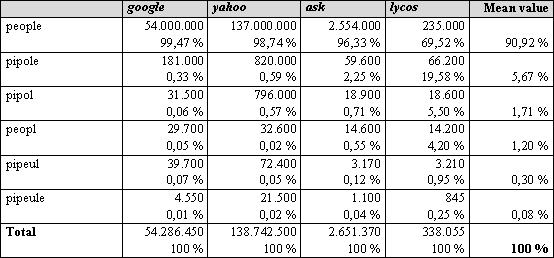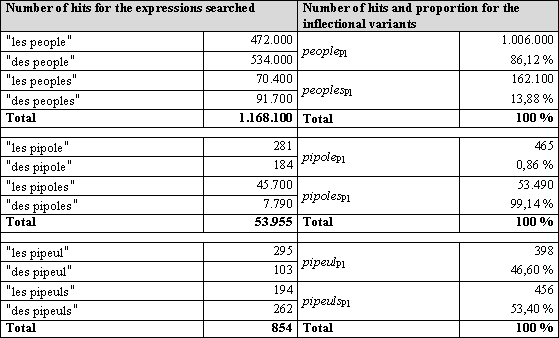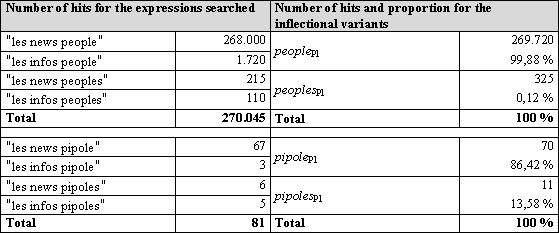| (27) | Le Nouvel An des people. Les célébrités aiment à se retrouver pour réveillonner. (article dated 01.01.2009, <http://www.leparisien.fr/loisirs-et-spectacles/le-nouvel-an-des- people-01-01-2009-358873.php>, last access 2009-01-12, emphasis added) |
| (28) | Dis AD, c'est une "pipole" la fille sur la photo ? ou une star de qq chose ? tu l'as vue où ? (posting in an Internet discussion, author: MAJOR TOM, 16.12.2005, <http://aigredouce.canalblog.com/archives/2005/12/15/1111926.html>, last access 2009-01-12, emphasis added) |
| (29) | Une vrai [sic, EWF] célébrité, un pipeul ! […] (posting in an Internet discussion, december 2008, author: ???, <http://fr.answers.yahoo.com/question/index?qid=20081224030355AA6HxT2 >, last access 2009-01-12, emphasis added) |
A query based on common Internet search engines (google, yahoo, ask, lycos) confirms that these variants are relatively widespread (see Table 1), with a clear predominance of <people>.19 For the derivations, in contrast, variants in <pipol-> are well attested: here <pipolisation>, <pipoliser>, etc. are the most frequent variants, followed by variants in <peop(o)l-> (<peopolisation>, <peopoliser>, etc., and <peoplisation>, <peopliser>, etc.).20

Table 1: Comparison of the number of hits for F. people and widespread variants
Let us first focus on the variants for people. We can observe that the consonants <p p l> remain stable in all occurring variants, and that variance only affects the graphic realization of the vowel segments.21 In order to evaluate the different forms with respect to the degree of loanword integration into the TL, two main criteria can be used: 1) conformity to the SL form, and 2) conformity to the TL system (Winter-Froemel 2008b; 2009a: 83–108). Each of the criteria can assume two values (conformity vs. non-conformity), so that their combination results in four main options:
TRANSFERENCE = conformity to the SL form and non-conformity to the TL system
INTEGRATION = non-conformity to the SL form and conformity to the TL system
CORRESPONDENCE = conformity to the SL form and conformity to the TL system
ALLOGENISM = non-conformity to the SL form and non-conformity to the TL system
The spelling <people> remains fully faithful to the English source form. However, it contains a structural pattern which does not conform to the system of the TL, namely the graphic segment <eo>. This means that the form is characterized by a transference in the segment <eo> and by correspondences in the other segments (<p>, <l>, <e>). Furthermore, for the widespread pronunciation variants [pi'pɔl] and [pi'pœl], some of the correspondences between the phonic segments of these forms and the graphic segments of <people> ([i] ↔ <eo>, [ɔ] ↔ <–> / [œ] ↔ <–>) do not conform to the grapheme-to-phoneme correspondence rules of French.

